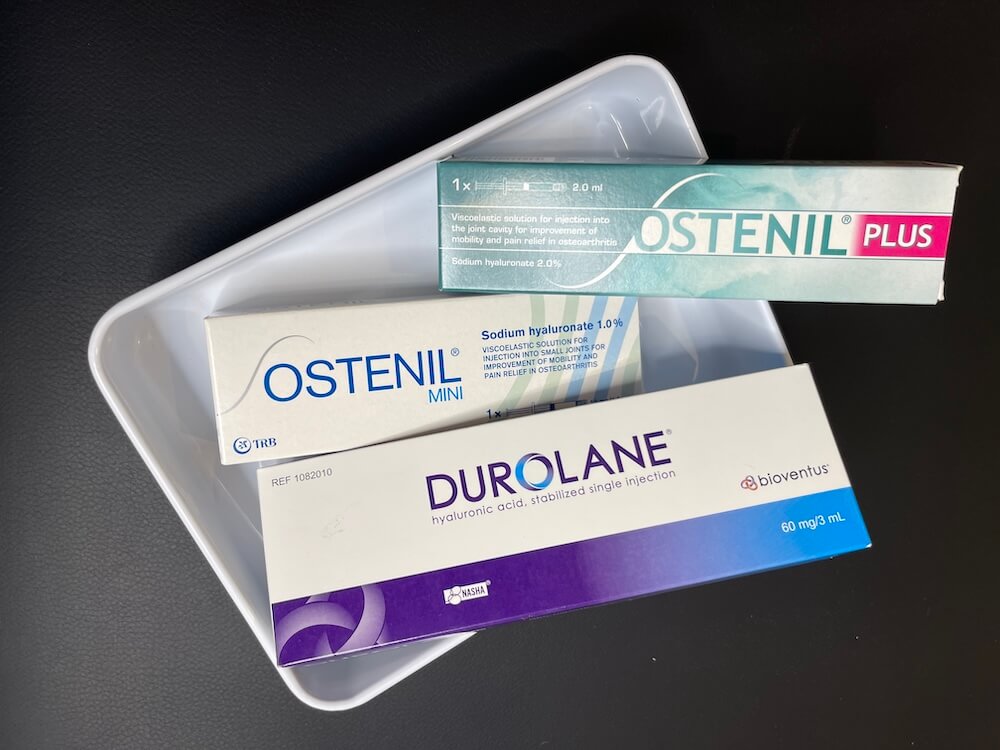What Are Hyaluronic Acid Injections

One of the most important differences between available hyaluronic acid products is their molecular weight. Low molecular weight formulations are designed to mimic the natural fluidity of synovial fluid, dispersing well throughout the joint space. They provide temporary lubrication and are often used in earlier stage disease or in smaller joints. Medium molecular weight HA provides a balance of lubricating and cushioning effects, with research suggesting benefits in terms of pain relief and improved function over several months (Altman et al., 2019). High molecular weight hyaluronic acid has a thicker, more viscous consistency, offering greater cushioning, improved resistance to breakdown, and longer-lasting symptom relief. Evidence indicates that high molecular weight HA is particularly effective in moderate to severe osteoarthritis, where joint degeneration is more advanced and protection of the cartilage surfaces is essential (Kotevoglu et al., 2006; Bowman et al., 2018).
Another distinction is the volume administered. Small joints such as the base of the thumb or the first metatarsophalangeal joint typically only require 1 ml of hyaluronic acid, whereas larger joints such as the knee or hip may require 2–3 ml to achieve optimal coverage. Matching the volume to the size of the joint ensures that the injected HA distributes effectively within the synovial space without excessive distension.
The mechanism by which hyaluronic acid improves symptoms is thought to extend beyond simple lubrication. It has been shown to reduce inflammation within the synovium, improve the production of endogenous HA by synovial cells and influence pain pathways at a cellular level (Bannuru et al., 2022). Clinical studies have demonstrated that viscosupplementation can reduce pain, improve joint function and delay the need for surgical intervention in selected patients (Maheu et al., 2019). While no injection can reverse established osteoarthritis, HA therapy offers a safe and evidence-based method of improving quality of life, particularly when combined with strengthening programmes, weight management and other adjunct treatments.
At The Injury Hub, we tailor the type and dose of hyaluronic acid to the needs of each individual joint. Smaller joints with mild disease may benefit from a lower molecular weight or smaller volume, while patients with more advanced arthritis in weight-bearing joints may achieve better results with high molecular weight formulations. This personalised approach ensures that treatment is both safe and effective, providing relief while protecting the long-term health of the joint.
References
Altman, R.D., Bedi, A., Karlsson, J., Sancheti, P. and Barthel, H.R. (2019) ‘Product differences in intra-articular hyaluronic acids for osteoarthritis of the knee’, American Journal of Sports Medicine, 47(2), pp. 487–496.
Bannuru, R.R., Osani, M.C., Vaysbrot, E.E., Arden, N.K., Bennell, K., Bierma-Zeinstra, S.M.A., Kraus, V.B., Lohmander, L.S., Abbott, J.H., Bhandari, M., Blanco, F.J., Espinosa, R., Haugen, I.K., Lin, J., Mandl, L.A., Moilanen, E., Nakamura, N., Snyder-Mackler, L., Trojian, T. and McAlindon, T.E. (2022) ‘OARSI guidelines for the non-surgical management of knee, hip, and polyarticular osteoarthritis’, Osteoarthritis and Cartilage, 30(4), pp. 481–500.
Bowman, S., Awad, M.E., Hamrick, M.W., Hunter, M. and Fulzele, S. (2018) ‘Recent advances in hyaluronic acid based therapy for osteoarthritis’, Clinical and Translational Medicine, 7(1), pp. 6–12.
Kotevoglu, N., Iyibozkurt, P.C., Hiz, O., Toktas, H. and Kuran, B. (2006) ‘A prospective randomised controlled clinical trial comparing the efficacy of different molecular weight hyaluronic acid products in knee osteoarthritis’, Rheumatology International, 26(4), pp. 325–330.
Maheu, E., Bannuru, R.R., Herrero-Beaumont, G., Allali, F., Bard, H., Migliore, A. and Berenbaum, F. (2019) ‘

Hyaluronic acid (HA) is a naturally occurring substance found in the synovial fluid of healthy joints. It plays a key role in providing lubrication, shock absorption and smooth movement between the articulating surfaces of the joint. In osteoarthritis and other degenerative joint conditions, the natural concentration and quality of hyaluronic acid within the joint reduces. This contributes to pain, stiffness and mechanical dysfunction. Injecting HA directly into the affected joint, a treatment often referred to as viscosupplementation, aims to restore the normal viscoelastic properties of the synovial fluid and improve joint mechanics.
Some treatments which benefit from using this method are: